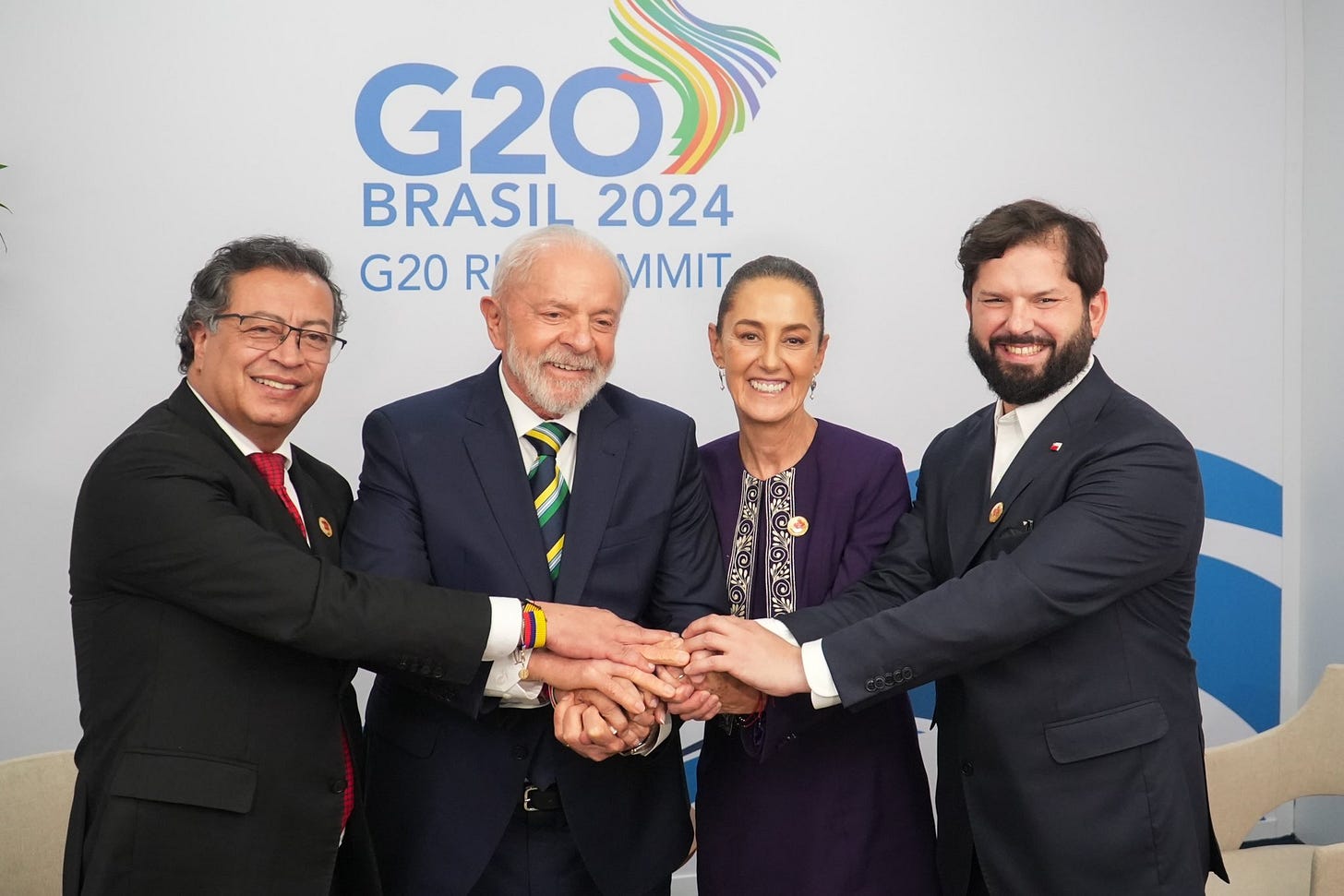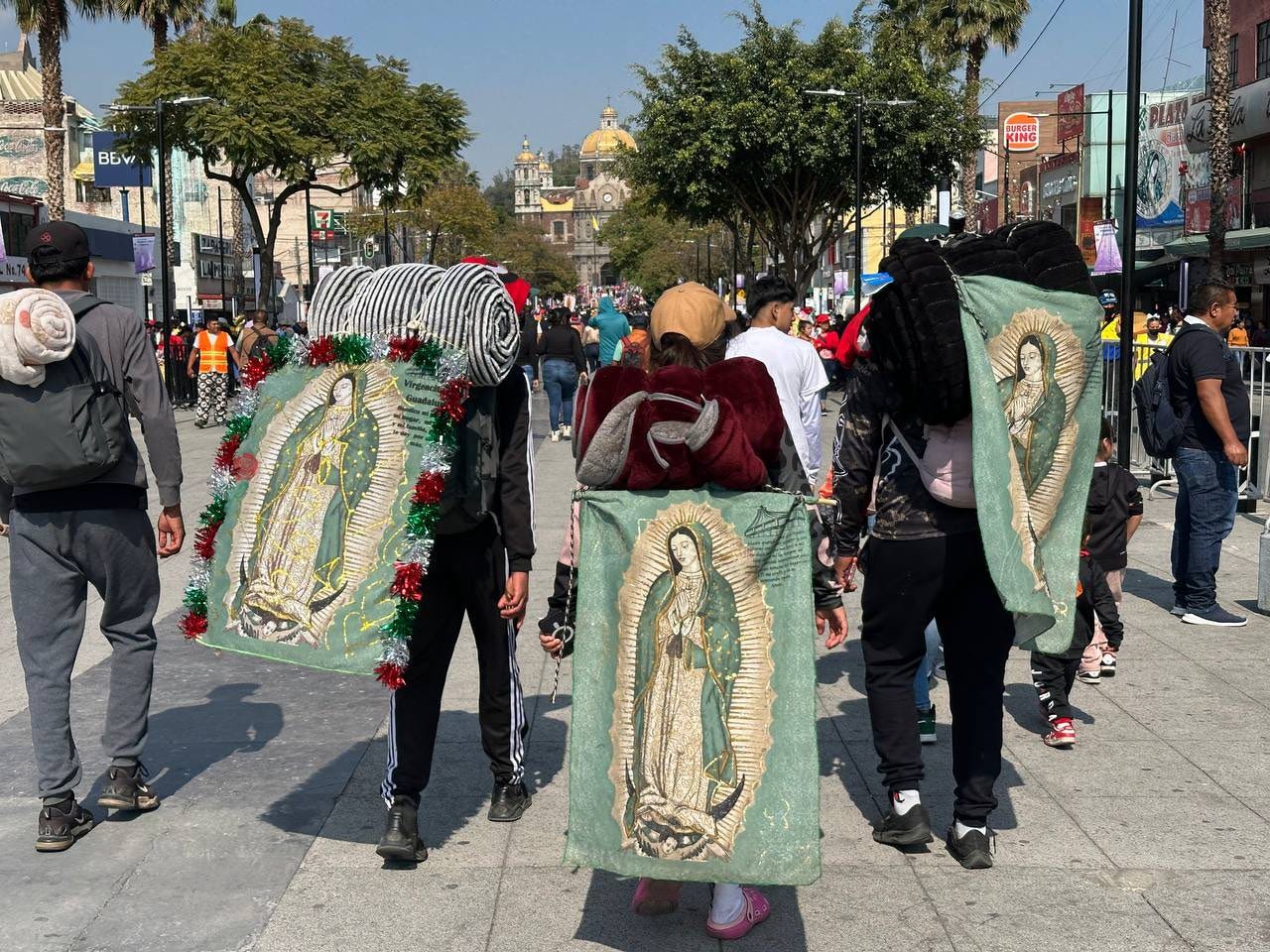Breaking bad...or good?
Guadalupe-Reyes-Trump
Welcome to the year’s last news roundup edition of The Mexpatriate.
‘Tis the season for lists: the good, the bad and the silly. From your Spotify Wrapped to the Oxford word of the year to Time Magazine’s Person of the Year, now is the time to reflect on 2024 and how we went from “rizz” to “brain rot,” and from Taylor to Trump.
In Mexico, the events of the end of last year are echoing today. President López Obrador had promised Biden more action on fentanyl and shook hands with Xi Jinping at the APEC summit in November, and by the ides of December, Claudia Sheinbaum and Xóchitl Gálvez were in full official pre-campaign mode, and Samuel García had flamed out of his. Omar García Harfuch won the Morena poll to run for mayor of Mexico City, but was replaced with Clara Brugada to comply with gender quotas. And AMLO’s locomotive dream, the Tren Maya, was on the cusp of its grand opening. Today, on its one-year anniversary, President Sheinbaum inaugurated the remaining two sections to complete the 1,554-km railway.
The morenistas in the above paragraph continue to make headlines today, while the others have faded into the background (except President Xi, that is). This year has been a triumph for the party of AMLO, though “El Peje” himself has left the national conversation since Sheinbaum was sworn in on Oct. 1.
As we see 2025 approaching on the horizon, there are high expectations for the “segundo piso” of the 4T—and mounting challenges.
In November, Sheinbaum had a 69% approval rating—not as high as AMLO’s in the early days of his administration (around 80%), but still better than any other Mexican president. While Sheinbaum and Morena have consolidated their power and their political agenda, they face problems both familiar and new: a restricted federal budget, the chronic pain of crime and of course, round two of Donald Trump in the White House.
As analyst Vanessa Romero Rocha put it: “The dream Claudia Sheinbaum may have had on June 2 of everything being perfect has been fading…the sexenio of Sheinbaum will be anything but straightforward.”

Sheinbaum made her international debut at the G20 summit in Brazil in November, where she proposed in her speech that 1% of the major global powers’ annual military budgets should be redirected to reforestation, inspired by Mexico’s “Sembrando Vida” program:
“It’s absurd and senseless that more is spent on weapons than on addressing poverty or climate change. We would reduce migration and hunger if we could only elevate the word of love over hate, the generosity of the humble and dispossessed person above greed.”
Meanwhile, the budget for Mexico’s environmental departments and programs for 2025 has been slashed by about 40%.
But the reaction to Sheinbaum’s presence on the global stage is a contrast to the response to AMLO, inviting more polite accolades than ridicule. Global media has started to warm up to the “steely character” of North America’s first woman president—she was selected by Forbes as the fourth-most powerful woman in the world, and made it on the Financial Times’ list of 25 most influential women of 2024.
Sheinbaum also shook hands with Xi Jinping at the G20, and took the opportunity to press Biden for full disclosure on the capture of “El Mayo” Zambada, which seems about as likely to happen as global governments switching out spending on tanks to trees.
This week, Trump’s nomination for U.S. ambassador to Mexico was announced: Ronald Johnson, who is ex-CIA, a former Green Beret and ambassador to El Salvador, and would be the first career-military U.S. ambassador to Mexico in 120 years. The message is loud and clear and it smells like “Fight Fight Fight.”
It has been a year of change; of unsurprising firsts, and unexpected seconds. We have Mexico’s first woman president—elected on a promise to “continue the change”—and we have “Make America Great Again”…again.
And yet, some things remain stubbornly the same. Over 11 million pilgrims flocked to Mexico City this week to honor the Virgin of Guadalupe’s appearance 493 years ago—a reminder of the steadily flowing river of ritual and faith that follows its course, unfazed, as Mexico faces 2025.
Kicking a hornet’s nest in México state
On Nov. 22, over 1,500 federal and local law enforcement and military agents carried out an operation known as “Enjambre” or “Swarm” in municipalities across México state, arresting seven public officials, including the mayor of Amanalco (near Valle de Bravo) and the husband of the mayor of Tonatico. All have been charged with colluding with organized crime in a region that has seen a rise in extortion and violence.
The joint operation is ongoing, with a total of 24 arrests made to date (10 of them police officers), and has had a dramatic media impact. One of the suspects, Isidro Cortés, the police chief of Texcaltitlán, shot and killed himself as he was read his rights.
Texcaltitlán made headlines almost exactly a year ago, when a bloody clash between locals and alleged members of the Familia Michoacana left 14 people dead. Cortés had been accused of having ties to this cartel, which is competing with the Cartel Jalisco Nueva Generación (CJNG) and the Unión de Tepito for territory in the state. México state ranks third of the seven states with the highest concentration of homicides in the country so far this year, behind Guanajuato and Baja California.
The mayor of Amanalco, María Elena Martínez Robles—elected on the Movimiento Ciudadano ticket in 2021 before joining Morena—has been charged with ordering the murder of another local official earlier this year. A police chief in Ixtapaluca is accused of extorting a market vendor for 5,000 pesos at gunpoint. Other charges include kidnapping and forced disappearance.
While the operation has been praised as a promising (if still early) demonstration of Sheinbaum’s security strategy, it is also a damning exposure of the municipal-level corruption that has taken root across Mexico. As described by analyst Carlos Pérez Ricart in Reforma:
“‘Enjambre’ is a slap in the face. It exposes the breakdown of the political system where it matters: on the ground, at the local level. The weakness of municipal order is reflected there: in the extra cost added to the price of avocados, in the cash payment to the municipal treasurer, in the taxi driver tipping off the lookout, in the burning down of the tortilla shop that didn’t pay the extortion.”
What makes “Enjambre” different from previous takedowns? Why does it make security analysts cautiously optimistic?
“Here there is investigation and intelligence,” said Sheinbaum at a press conference a few days after the operation, reiterating the four pillars of her security strategy: attention to root causes, strengthening the National Guard, intelligence and coordination.
She emphasized the prior investigative work that led to the “Enjambre” arrest warrants, in contrast with the so-called “Michoacanazo,” a showy roundup of 11 mayors and other public officials in the state in 2009. They were all later exonerated and released due to lack of evidence.
“When intelligence and investigation reveal data or information showing that an authority is involved…what is done?” said Sheinbaum. “What wasn’t done in the era of Calderón…it is taken to court.”
Also worth noting is the fact that the operation wasn’t partisan, with politicians from Morena and various opposition parties arrested.
The operation was made public a few days before Congress approved a constitutional reform granting expanded investigative and strategic powers to the national Department of Public Security and Citizen Protection (SSPC), led by Sheinbaum’s former security chief in Mexico City and now “security czar” Omar García Harfuch. The “Harfuch law” passed unanimously, with no abstentions.

While the reform does give Harfuch more centralized investigative and auditing power, “he’s a czar without an army,” as noted by analyst Carlos Bravo Regidor. The SSPC must rely on the National Guard and armed forces, as well as state and local law enforcement, to execute operations. He’s also a czar with a small purse—the 2025 federal budget reduced the funds for the SSPC by 36% (however, next year’s annual budget is still bigger than it was from 2020-2022).
It’s hard not to be reminded of an earlier García— the disgraced “super cop” Genaro García Luna, who was sentenced to 38 years in prison in the U.S. in October for colluding with drug traffickers. García Luna was the head of security under Calderón, though his department lacked the investigative authority now bestowed on the SSPC. Despite the risks of centralization, experts like David Saucedo (quoted below) seem to agree this is a necessary step:
“I think a 'czar' is indeed needed in the area of security, someone who can coordinate the efforts of many agencies that operate more or less in the same direction but have their own leadership. What is needed is a unified command.”
Building a case through investigation and intelligence work; coordinating with federal and local agencies; executing arrest warrants. This may sound like the ABCs of law enforcement but in Mexico, it’s a cause for cautious celebration.
Mexico in space
In her presentation of the new Advisory Council of Regional Economic Development and Business Relocation (CADERR) on Nov. 27, director Altagracia Gómez Sierra presented various initiatives to promote Mexican manufacturing and technological prowess. But the proposal that raised the most eyebrows was an all-Latino space mission in 2027, led by Mexico in collaboration with the first Mexican-born woman to go to space, 28-year-old electrical engineer Katya Echazarreta.
“These are three examples of how we will collaborate with the private sector, and of course, with academia,” said Gómez, the 32-year-old heiress and president of congolmerate Grupo Minsa, who has become a close advisor to Sheinbaum and her liasion with Mexico’s business community. The other two objectives she referenced are the launch of a 100% Mexican satellite and an entirely made-in-Mexico motor.
Gómez also pointed out that the aerospace industry in Mexico has investors who think “long term,” and has grown substantially in the last twenty years, creating “highly specialized” jobs.
But how likely is it that Mexico can achieve these lofty goals?
The Mexican Space Agency (AEM) was founded in 2010 under the administration of Felipe Calderón and operates under the umbrella of the Department of Transportation, Communication and Infrastructure (SICT). To date, its accomplishments have been modest. Most recently, the AEM worked with UNAM and NASA as part of the first privately operated lunar landing mission—but Peregrine unfortunately failed to make it to the moon after its launch in January.
No details have been revealed about this 2027 all-Latino mission—manned or unmanned? Destination International Space Station, or somewhere else in the solar system?
The proposal has already been criticized by the first Mexican astronaut to travel to space, Rodolfo Neri Vela, who slammed the selection of Echazarreta, calling her a “young media-savvy tourist” with an “inflated resumé” in a post to X. Neri had previously been critical of another mention of Echazarreta by AMLO, when Bill Nelson, the administrator of NASA, visited Mexico City in April.
While Neri claims he isn’t trying to discredit Echazarreta, he thinks she has been chosen “without reflection” and (grouchily) lamented the lack of effort to expand the talent search in an interview with Wired:
“So many young [Mexican] men and women have dreamed for decades of going to space and are waiting for the chance to compete to see if they are selected. They would see their dreams crushed simply because the president decided to arbitrarily appoint someone, as if picking someone to go buy sodas.”
This mission comes at an interesting moment for space exploration. Echazarreta’s journey to space was on a Bezos-owned Blue Origin flight, and of course, Musk’s SpaceX looks like it’s going to infinity and beyond under Trump 2.0. India became only the fourth country to land a spacecraft on the moon last year, and is working on a manned mission by 2040, while NASA has repeatedly delayed its Artemis program to send the first crewed mission to the moon in over 50 years. Gómez seems to at least be on the right path with the coordinated public-private approach.
It’s easy to be skeptical of these initiatives—including the Mexican-made EV that Sheinbaum has also pledged in her term—but they all point to what could become her “sello propio” as president: an effort to cultivate more homegrown scientific innovation.
Walter Blanco?
“There is a [television] show … that takes place in … New Mexico.”
Claudia Sheinbaum brought up Breaking Bad in a press conference on Dec. 2 in response to a reporter’s questions about a New York Times investigative report on cartel recruitment of college chemistry students.
“Maybe that’s where they got the report from, right?”
Sheinbaum’s dismissal of the story—which includes interviews with cartel recruiters and students who claim they are working to help make cartels synthesize their own precursor chemicals—ignores previous reports by Mexican authorities that were leaked during the Guacamaya hack of 2022, which indicated cartels were recruiting chemistry professors as part of the “nearshoring” of their manufacturing during the pandemic.
Meanwhile, Mexico made its single largest fentanyl seizure ever—over 1,000 kilograms of the synthetic opioid, with an estimated value of US $400 million—in Ahome, Sinaloa on Dec. 3, a week after Trump said he’d slap tariffs on Mexico until the “invasion” of drugs and crime stops. Two arrests were made in the operation.
Mexico’s seizures of fentanyl have risen steadily in recent years, but dropped off in 2024—authorities seized 2,329 kilos of fentanyl in 2023, but merely 130 kg in the first six months of this year.
And we’ve gone from sharks testing positive for cocaine off the Brazilian coast to a new study detecting fentanyl in dolphins in the Gulf of Mexico.
¡Vaya año este 2024!
Thank you for reading and feel free to send me your suggestions, comments and questions at hola@themexpatriate.com. If you’re new here, please check out this page to learn more about The Mexpatriate.
*Note: I will be taking a week off for the holidays, so I’ll be back in your inbox on Dec. 29.







